SEO
How do you hire an SEO manager?

30-second summary:
- Business leaders struggle to hire SEO managers, and often wonder if they need one
- SEO visibility is key to business success and is hard to increase your customer base and sales
- SEO is a great contributor to brand growth and essentially needs the right mindset
- This is a checklist to help you hire the right fit for your business
If you’re looking to improve your website’s search engine ranking, you may be wondering how to go about hiring an SEO manager. It can be a daunting task, but with the right information, it can be more straightforward than you think.
In this article, we will discuss some of the things you should consider when hiring an SEO manager. We’ll also provide some tips on how to make sure your team works well together and gets the most out of your SEO manager.
Why hire an SEO manager?
Without an SEO manager, it’s often difficult to know where to start when it comes to improving your website’s search engine visibility. And without valuable organic traffic, it’s hard to increase your customer base and sales. SEO can be a big contributor to brand growth.
An SEO manager can help you identify the best strategies for improving your website’s search presence. They will also be able to monitor overall performance, spot potential improvement opportunities, and create effective tactics to get the best results from your website’s content.
This includes conducting keyword research and creating SEO content, optimizing existing website pages, analyzing traffic sources, managing link-building campaigns, monitoring search engine performance, and regularly reporting on the progress of organic traffic. An SEO manager will ensure that your business sees SEO progress much more quickly.
What responsibilities does an SEO manager have?
The primary responsibility of an SEO manager is to ensure that your website ranks as high as possible in search engine results (not just Google, but Bing, and Amazon too).
If you’re not on the first page of Google for your most important keywords, you’re missing huge sales opportunities. This is particularly true for ecommerce SEO, where a poorly-performing website and SEO strategy can literally be the difference between a thriving business and bankruptcy.
It is crucial to hire an SEO manager who understands all aspects of SEO, including technical SEO, content-related tasks, analytics tracking, website performance, and link building.
They should have the ability to assess the current health of a website, developing plans to improve ranking in organic search results. The successful candidate should also be able to track and analyze performance metrics, such as click-through rates, conversion rates, and bounce rates.
What characteristics make a good SEO manager?
When looking for an SEO manager, you’ll want to find someone who is knowledgeable in the field, has good communication skills, is a self-starter, and can work independently.
Personality traits are key too. The person should be creative, persistent, and have a passion for problem-solving. They should also have good organizational skills and the ability to prioritize tasks.
It is important that the SEO manager you hire is a team player, and can take direction from upper management. Having the ability to build relationships with stakeholders and clients is also essential.
The importance of project management
Project management skills are essential for an SEO manager as they will need to coordinate activities between multiple teams and departments, manage timelines and budgets, and report on project progress.
Without good project management skills, an SEO manager will struggle to get results and could cause delays in achieving desired outcomes.
How can you ensure that your team gels well?
The key to creating a successful SEO team is finding people with complementary skills who work well together. This involves looking for individuals who have experience in different aspects of digital marketing, such as content writing, web design, and analytics.
You don’t want to hire a team of people who are all experts in the same field, as this will limit your team’s ability to think creatively and come up with innovative ideas.
It is also important to ensure that your SEO manager has good interpersonal skills. Having an open-door policy where everyone can easily communicate with each other is essential. This will help build trust between team members and ensure everyone is on the same page.
Having an open dialogue between all team members will also be crucial. This will ensure their feedback and input on how best to optimize the content or improve strategies.
Ideas for welcoming and onboarding your new hire
This could include creating an onboarding checklist, setting up regular meetings, assigning tasks to the team members, and scheduling time for team-building activities. Do make sure your SEO manager has face time with key leads from across the business to get a strong understanding of the business and its needs. This pays off in the long run.
Hiring in-house vs SEO outsourcing
When it comes to deciding if you should hire an in-house SEO manager, outsource the work to an SEO agency, or simply get a freelancer – you need to gauge the pros and cons.
Hiring in-house may be more expensive but can provide a greater level of control and allows for closer collaboration with the team. You totally own your processes and have granular input on everything.
On the other hand, outsourcing to an agency or freelance professional may be more cost-effective and can provide specialized skills that are not available in-house. Many SEO providers will offer types of monthly SEO packages, which make costs predictable and controllable. And depending on the terms of a contract, you likely have the freedom to cancel whenever you like. This can be much less hassle than employing someone – a poorly-performing employee, which can be more troublesome to resolve.
| Hiring in-house | Hiring an SEO agency or freelancer | |
| Pros | • Greater control and collaboration
• Easier to monitor progress • Assign tasks quickly |
• Affordable
• Access to specialized skills • High level of expertise and experience |
| Cons | • Can be more expensive
• Limited experience level • Can be difficult to find the right candidate
|
• Lack of control over the process
• Communication can be more difficult • Accountability can be less clear |
Interview questions to ask your potential SEO manager
When interviewing a potential SEO manager, you should ask some specific questions to make sure they are the right fit. These can include questions about their experience with SEO, how they stay up-to-date on algorithm changes, and what strategies they would use to improve your website’s ranking.
Example starter questions
- What experience do you have with SEO?
- How do you stay up to date on algorithm changes?
- What strategies would you use to improve our website’s ranking?
- How would you optimize our content for search engine visibility?
- What kind of link-building tactics do you employ?
- What do you consider to be the most important SEO trends?
Common mistakes to avoid when hiring a new candidate
When hiring an SEO manager, there are some common mistakes you should avoid:
Not understanding the responsibilities of an SEO Manager
It is vital you have a clear idea of what the job entails and that the candidate has the relevant skills for the position.
Not considering the team’s current culture
When bringing someone new onto your team it is important to consider how they will fit in with existing colleagues.
Not asking enough questions during interviews
Make sure you ask any potential candidates about their experience and qualifications, as well as their ability to work with the team and manage client relationships.
Not setting clear goals for the role
Setting clear expectations will ensure that everyone is on the same page from the outset and that any targets are achievable.
Not agreeing on a budget
Before you start your search, make sure to set a realistic budget for this role. This will help you determine how much you can afford to pay, and what kind of person is best suited to the job.
Not conducting background checks
Background checks are important when hiring an SEO manager as they will provide insight into their past experience and any qualifications they may have. It’s also a good way to make sure that there are no discrepancies in their resume.
FAQ
Q: How do I find an SEO manager?
A: You can look for SEO managers on job boards, or hire a freelancer or agency. Make sure to ask them questions about their experience and qualifications, as well as their ability to work with the team and manage client relationships.
Q: What should I look for in an SEO manager?
A: A good SEO manager should have experience with SEO, and up-to-date knowledge of algorithm changes and strategies to improve a website’s ranking. They should also be able to optimize content for search engine visibility, employ link-building tactics and keep track of the latest SEO trends.
Q: How much does it cost to hire an SEO manager?
A: The cost of hiring an SEO manager will depend on the level of experience, skills, and services required. Generally, in-house managers can be more expensive than agencies or freelance professionals. It’s important to set a realistic budget before you start your search.
Q: Is it a good idea to hire an SEO manager overseas to work remotely?
A: This depends on the situation. Hiring a remote SEO manager can be beneficial if they are highly experienced and able to deliver results, however, communication and accountability can be more challenging with remote workers. It’s important to weigh up the pros and cons before making your final decision. There may also be legal or compliance issues when employing internationally.
Closing thoughts
Finding the right SEO manager is an important step in ensuring your website’s success. Make sure to ask potential candidates plenty of questions and take into account their skills, experience, and ability to fit into the team culture before making a decision. Consider both the benefits and disadvantages of hiring an in-house employee or outsourcing to an agency or freelancer, and don’t forget to set a budget. With the right candidate on board, you’ll be well on your way to achieving long-term SEO success.
Joe Dawson is Director of strategic growth agency Creative.onl, based in the UK. He can be found on Twitter @jdwn.
Subscribe to the Search Engine Watch newsletter for insights on SEO, the search landscape, search marketing, digital marketing, leadership, podcasts, and more.
Join the conversation with us on LinkedIn and Twitter.
SEO
Google’s Search Engine Market Share Drops As Competitors’ Grows

According to data from GS Statcounter, Google’s search engine market share has fallen to 86.99%, the lowest point since the firm began tracking search engine share in 2009.
The drop represents a more than 4% decrease from the previous month, marking the largest single-month decline on record.
U.S. Market Impact
The decline is most significant in Google’s key market, the United States, where its share of searches across all devices fell by nearly 10%, reaching 77.52%.
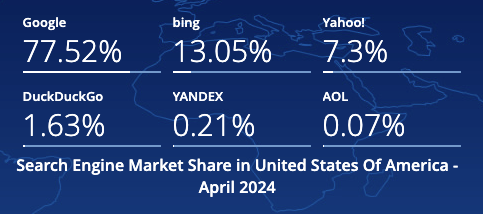 Screenshot from: https://gs.statcounter.com/search-engine-market-share/, May 2024.
Screenshot from: https://gs.statcounter.com/search-engine-market-share/, May 2024.Concurrently, competitors Microsoft Bing and Yahoo Search have seen gains. Bing reached a 13% market share in the U.S. and 5.8% globally, its highest since launching in 2009.
Yahoo Search’s worldwide share nearly tripled to 3.06%, a level not seen since July 2015.
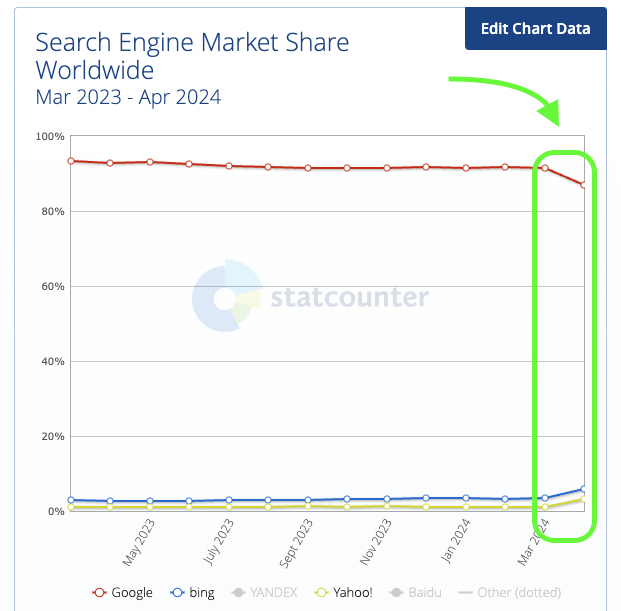 Screenshot from: https://gs.statcounter.com/search-engine-market-share/, May 2024.
Screenshot from: https://gs.statcounter.com/search-engine-market-share/, May 2024.Search Quality Concerns
Many industry experts have recently expressed concerns about the declining quality of Google’s search results.
A portion of the SEO community believes that the search giant’s results have worsened following the latest update.
These concerns have begun to extend to average internet users, who are increasingly voicing complaints about the state of their search results.
Alternative Perspectives
Web analytics platform SimilarWeb provided additional context on X (formerly Twitter), stating that its data for the US for March 2024 suggests Google’s decline may not be as severe as initially reported.
From our data (Search Engine website category, US, March 2024) it doesn’t look like we’re there yet: pic.twitter.com/RBUJp4ZLeb
— Similarweb (@Similarweb) May 1, 2024
SimilarWeb also highlighted Yahoo’s strong performance, categorizing it as a News and Media platform rather than a direct competitor to Google in the Search Engine category.
Don’t underestimate Yahoo. They’re doing great. On our platform they’re categorized as News and Media, and hence not a direct competitor to Google in the Search Engine category. But they rank #10 worldwide, #6 in the US, and #1 in their category. Much higher than Bing and OpenAI. pic.twitter.com/O4yJu5QEK6
— Similarweb (@Similarweb) May 2, 2024
At the same time, Google is slightly declining 👀 pic.twitter.com/9i7paeU1QG
— Similarweb (@Similarweb) May 2, 2024
Why It Matters
The shifting search engine market trends can impact businesses, marketers, and regular users.
Google has been on top for a long time, shaping how we find things online and how users behave.
However, as its market share drops and other search engines gain popularity, publishers may need to rethink their online strategies and optimize for multiple search platforms besides Google.
Users are becoming vocal about Google’s declining search quality over time. As people start trying alternate search engines, the various platforms must prioritize keeping users satisfied if they want to maintain or grow their market position.
It will be interesting to see how they respond to this boost in market share.
What It Means for SEO Pros
As Google’s competitors gain ground, SEO strategies may need to adapt by accounting for how each search engine’s algorithms and ranking factors work.
This could involve diversifying SEO efforts across multiple platforms and staying up-to-date on best practices for each one.
The increased focus on high-quality search results emphasizes the need to create valuable, user-focused content that meets the needs of the target audience.
SEO pros must prioritize informative, engaging, trustworthy content that meets search engine algorithms and user expectations.
Remain flexible, adaptable, and proactive to navigate these shifts. Keeping a pulse on industry trends, user behaviors, and competing search engine strategies will be key for successful SEO campaigns.
Featured Image: Tada Images/Shutterstock
SEO
How To Drive Pipeline With A Silo-Free Strategy

When it comes to B2B strategy, a holistic approach is the only approach.
Revenue organizations usually operate with siloed teams, and often expect a one-size-fits-all solution (usually buying clicks with paid media).
However, without cohesive brand, infrastructure, and pipeline generation efforts, they’re pretty much doomed to fail.
It’s just like rowing crew, where each member of the team must synchronize their movements to propel the boat forward – successful B2B marketing requires an integrated strategy.
So if you’re ready to ditch your disjointed marketing efforts and try a holistic approach, we’ve got you covered.
Join us on May 15, for an insightful live session with Digital Reach Agency on how to craft a compelling brand and PMF.
We’ll walk through the critical infrastructure you need, and the reliances and dependences of the core digital marketing disciplines.
Key takeaways from this webinar:
- Thinking Beyond Traditional Silos: Learn why traditional marketing silos are no longer viable and how they spell doom for modern revenue organizations.
- How To Identify and Fix Silos: Discover actionable strategies for pinpointing and sealing the gaps in your marketing silos.
- The Power of Integration: Uncover the secrets to successfully integrating brand strategy, digital infrastructure, and pipeline generation efforts.
Ben Childs, President and Founder of Digital Reach Agency, and Jordan Gibson, Head of Growth at Digital Reach Agency, will show you how to seamlessly integrate various elements of your marketing strategy for optimal results.
Don’t make the common mistake of using traditional marketing silos – sign up now and learn what it takes to transform your B2B go-to-market.
You’ll also get the opportunity to ask Ben and Jordan your most pressing questions, following the presentation.
And if you can’t make it to the live event, register anyway and we’ll send you a recording shortly after the webinar.
SEO
Why Big Companies Make Bad Content
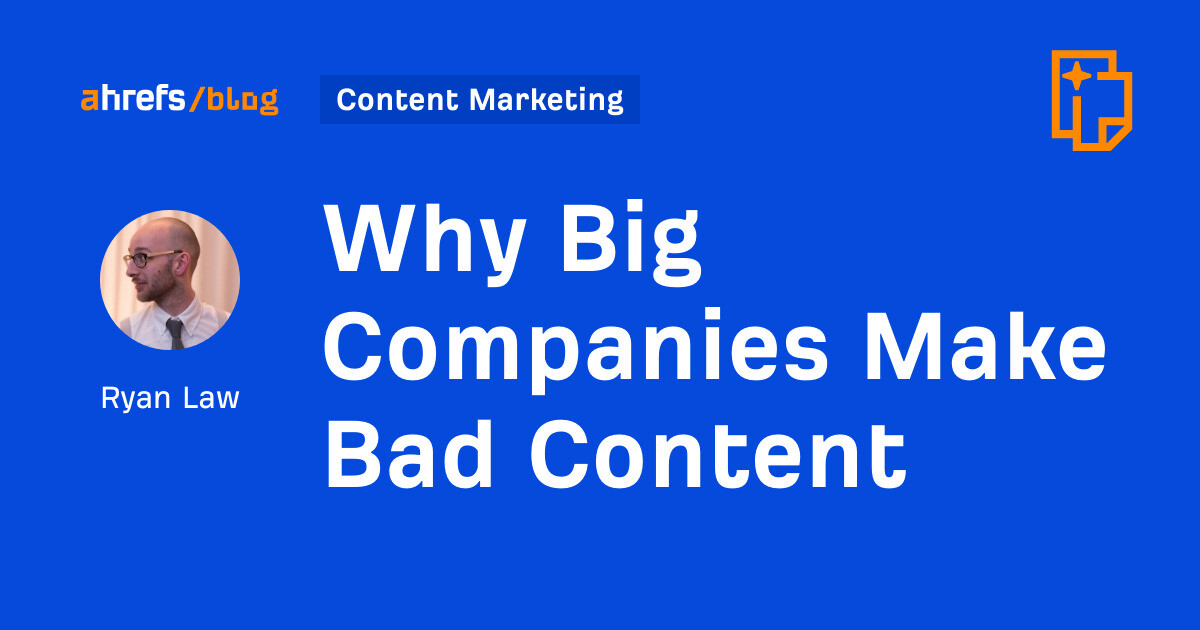
It’s like death and taxes: inevitable. The bigger a company gets, the worse its content marketing becomes.
HubSpot teaching you how to type the shrug emoji or buy bitcoin stock. Salesforce sharing inspiring business quotes. GoDaddy helping you use Bing AI, or Zendesk sharing catchy sales slogans.
Judged by content marketing best practice, these articles are bad.
They won’t resonate with decision-makers. Nobody will buy a HubSpot license after Googling “how to buy bitcoin stock.” It’s the very definition of vanity traffic: tons of visits with no obvious impact on the business.
So why does this happen?
There’s an obvious (but flawed) answer to this question: big companies are inefficient.
As companies grow, they become more complicated, and writing good, relevant content becomes harder. I’ve experienced this firsthand:
- extra rounds of legal review and stakeholder approval creeping into processes.
- content watered down to serve an ever-more generic “brand voice”.
- growing misalignment between search and content teams.
- a lack of content leadership within the company as early employees leave.
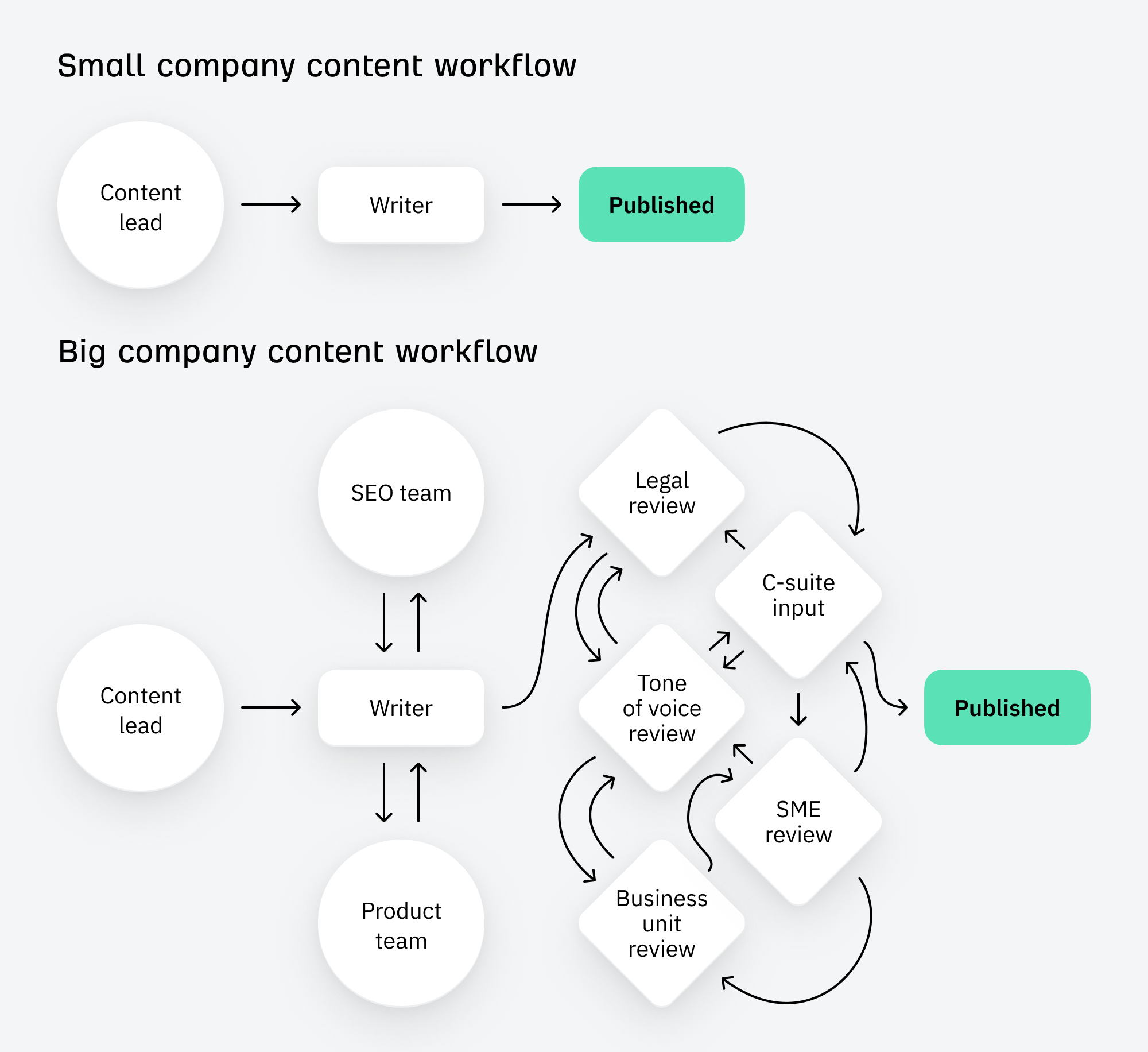

Similarly, funded companies have to grow, even when they’re already huge. Content has to feed the machine, continually increasing traffic… even if that traffic never contributes to the bottom line.
There’s an element of truth here, but I’ve come to think that both these arguments are naive, and certainly not the whole story.
It is wrong to assume that the same people that grew the company suddenly forgot everything they once knew about content, and wrong to assume that companies willfully target useless keywords just to game their OKRs.
Instead, let’s assume that this strategy is deliberate, and not oversight. I think bad content—and the vanity traffic it generates—is actually good for business.
There are benefits to driving tons of traffic, even if that traffic never directly converts. Or put in meme format:


Programmatic SEO is a good example. Why does Dialpad create landing pages for local phone numbers?


Why does Wise target exchange rate keywords?


Why do we have a list of most popular websites pages?


As this Twitter user points out, these articles will never convert…
…but they don’t need to.
Every published URL and targeted keyword is a new doorway from the backwaters of the internet into your website. It’s a chance to acquire backlinks that wouldn’t otherwise exist, and an opportunity to get your brand in front of thousands of new, otherwise unfamiliar people.
These benefits might not directly translate into revenue, but over time, in aggregate, they can have a huge indirect impact on revenue. They can:
- Strengthen domain authority and the search performance of every other page on the website.
- Boost brand awareness, and encourage serendipitous interactions that land your brand in front of the right person at the right time.
- Deny your competitors traffic and dilute their share of voice.
These small benefits become more worthwhile when multiplied across many hundreds or thousands of pages. If you can minimize the cost of the content, there is relatively little downside.
What about topical authority?
“But what about topical authority?!” I hear you cry. “If you stray too far from your area of expertise, won’t rankings suffer for it?”
I reply simply with this screenshot of Forbes’ “health” subfolder, generating almost 4 million estimated monthly organic pageviews:
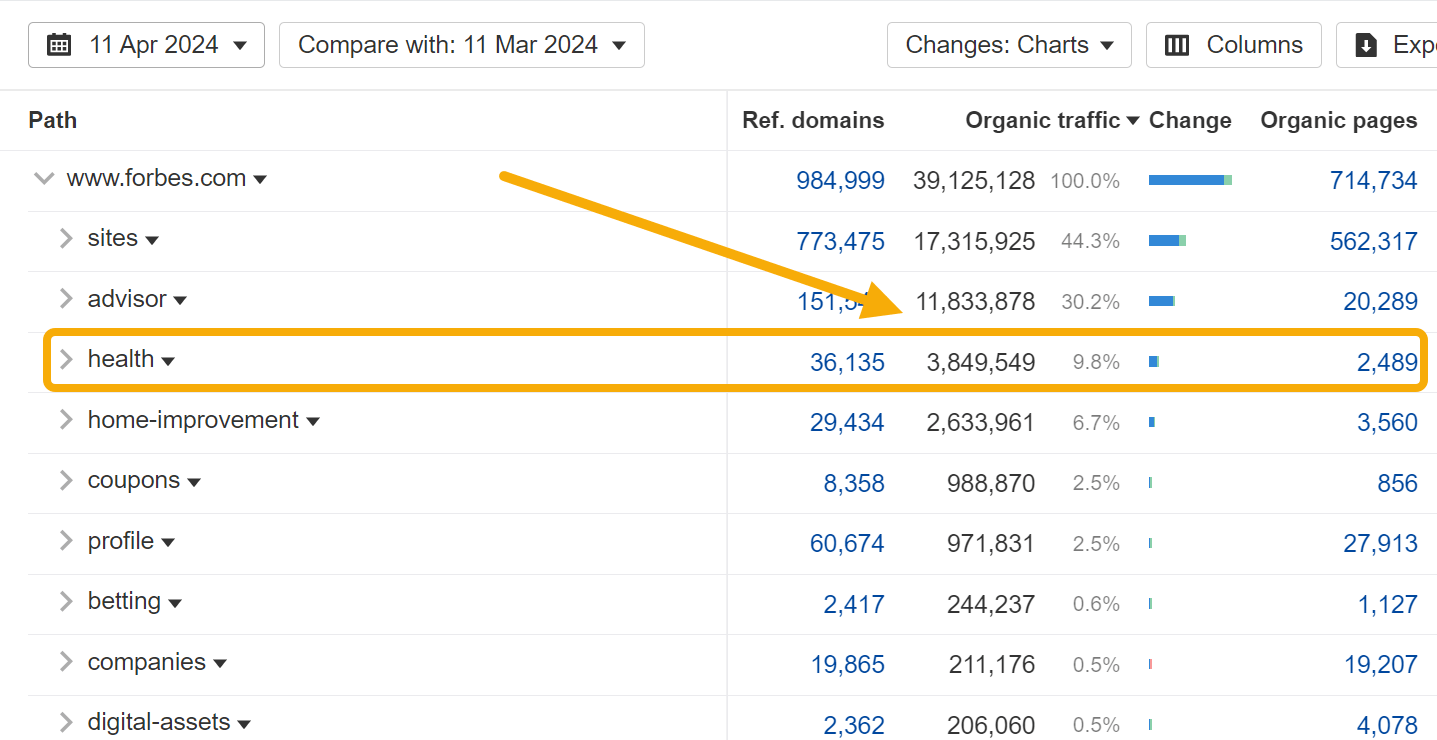

And big companies can minimize cost. For large, established brands, the marginal cost of content creation is relatively low.
Many companies scale their output through networks of freelancer writers, avoiding the cost of fully loaded employees. They have established, efficient processes for research, briefing, editorial review, publication and maintenance. The cost of an additional “unit” of content—or ten, or a hundred—is not that great, especially relative to other marketing channels.
There is also relatively little opportunity cost to consider: the fact that energy spent on “vanity” traffic could be better spent elsewhere, on more business-relevant topics.
In reality, many of the companies engaging in this strategy have already plucked the low-hanging fruit and written almost every product-relevant topic. There are a finite number of high traffic, high relevance topics; blog consistently for a decade and you too will reach these limits.
On top of that, the HubSpots and Salesforces of the world have very established, very efficient sales processes. Content gating, lead capture and scoring, and retargeting allow them to put very small conversion rates to relatively good use.


Even HubSpot’s article on Bitcoin stock has its own relevant call-to-action—and for HubSpot, building a database of aspiring investors is more valuable than it sounds, because…
The bigger a company grows, the bigger its audience needs to be to continue sustaining that growth rate.
Companies generally expand their total addressable market (TAM) as they grow, like HubSpot broadening from marketing to sales and customer success, launching new product lines for new—much bigger—audiences. This means the target audience for their content marketing grows alongside.
As Peep Laja put its:
But for the biggest companies, this principle is taken to an extreme. When a company gears up to IPO, its target audience expands to… pretty much everyone.
This was something Janessa Lantz (ex-HubSpot and dbt Labs) helped me understand: the target audience for a post-IPO company is not just end users, but institutional investors, market analysts, journalists, even regular Jane investors.
These are people who can influence the company’s worth in ways beyond simply buying a subscription: they can invest or encourage others to invest and dramatically influence the share price. These people are influenced by billboards, OOH advertising and, you guessed it, seemingly “bad” content showing up whenever they Google something.
You can think of this as a second, additional marketing funnel for post-IPO companies:
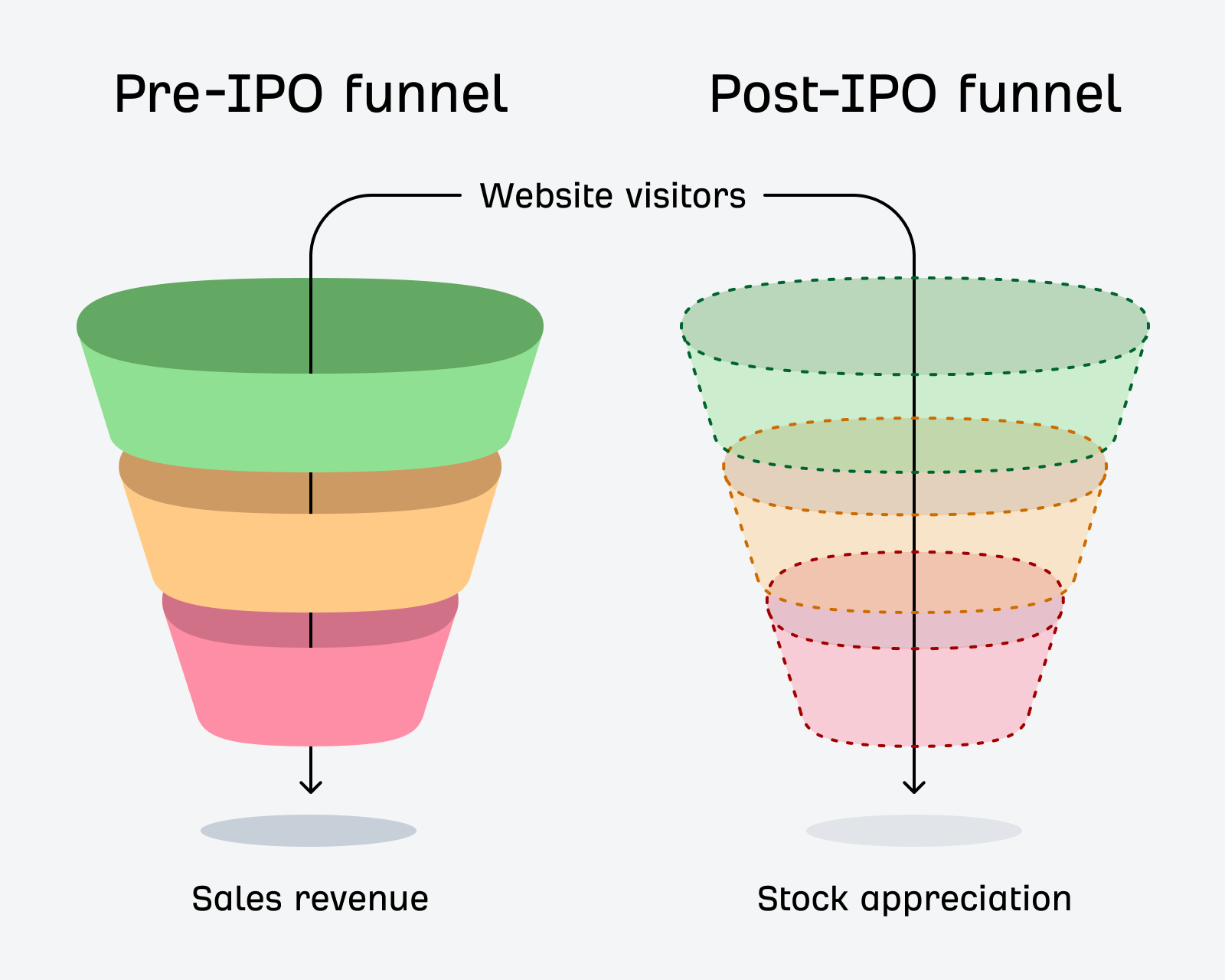

These visitors might not purchase a software subscription when they see your article in the SERP, but they will notice your brand, and maybe listen more attentively the next time your stock ticker appears on the news.
They won’t become power users, but they might download your eBook and add an extra unit to the email subscribers reported in your S1.
They might not contribute revenue now, but they will in the future: in the form of stock appreciation, or becoming the target audience for a future product line.
Vanity traffic does create value, but in a form most content marketers are not used to measuring.
If any of these benefits apply, then it makes sense to acquire them for your company—but also to deny them to your competitors.
SEO is an arms race: there are a finite number of keywords and topics, and leaving a rival to claim hundreds, even thousands of SERPs uncontested could very quickly create a headache for your company.
SEO can quickly create a moat of backlinks and brand awareness that can be virtually impossible to challenge; left unchecked, the gap between your company and your rival can accelerate at an accelerating pace.
Pumping out “bad” content and chasing vanity traffic is a chance to deny your rivals unchallenged share of voice, and make sure your brand always has a seat at the table.
Final thoughts
These types of articles are miscategorized—instead of thinking of them as bad content, it’s better to think of them as cheap digital billboards with surprisingly great attribution.
Big companies chasing “vanity traffic” isn’t an accident or oversight—there are good reasons to invest energy into content that will never convert. There is benefit, just not in the format most content marketers are used to.
This is not an argument to suggest that every company should invest in hyper-broad, high-traffic keywords. But if you’ve been blogging for a decade, or you’re gearing up for an IPO, then “bad content” and the vanity traffic it creates might not be so bad.
-

 WORDPRESS7 days ago
WORDPRESS7 days ago9 Best WooCommerce Multi Vendor Plugins (Compared)
-

 SEO6 days ago
SEO6 days agoGoogle March 2024 Core Update Officially Completed A Week Ago
-

 MARKETING5 days ago
MARKETING5 days agoNavigating the Video Marketing Maze: Short-Form vs. Long-Form
-

 SEARCHENGINES6 days ago
SEARCHENGINES6 days agoGoogle March 2024 Core Update Finished April 19, 2024
-
![The Current State of Google’s Search Generative Experience [What It Means for SEO in 2024] person typing on laptop with](https://articles.entireweb.com/wp-content/uploads/2024/04/The-Current-State-of-Googles-Search-Generative-Experience-What-It.webp-400x240.webp)
![The Current State of Google’s Search Generative Experience [What It Means for SEO in 2024] person typing on laptop with](https://articles.entireweb.com/wp-content/uploads/2024/04/The-Current-State-of-Googles-Search-Generative-Experience-What-It.webp-80x80.webp) MARKETING6 days ago
MARKETING6 days agoThe Current State of Google’s Search Generative Experience [What It Means for SEO in 2024]
-

 SEO7 days ago
SEO7 days agoGoogle Declares It The “Gemini Era” As Revenue Grows 15%
-
SEARCHENGINES5 days ago
Daily Search Forum Recap: April 26, 2024
-

 WORDPRESS6 days ago
WORDPRESS6 days agoNew WordPress.com Themes for April 2024 – WordPress.com News















You must be logged in to post a comment Login